Comparative Analysis of Air Quality in Agricultural and Urban Areas in Korea
Abstract
1. Introduction
2. Materials and Methods
2.1. Monitoring Sites
2.2. Measurement
2.3. Data Processing and Maintenance
3. Results
3.1. Comparative Analysis of Air Quality Between Agricultural and Urban Regions
3.2. Comparative Analysis of Air Quality in High-PM Event Periods
4. Conclusions
Author Contributions
Funding
Data Availability Statement
Conflicts of Interest
Abbreviations
| PM10 | Particulate matter with diameters less than 10 microns |
| PM2.5 | Particulate matter with diameters less than 2.5 microns |
| SO2 | Sulfur dioxide |
| NO2 | Nitrogen dioxide |
| AM | Ante meridiem |
| PM | Post meridiem |
| WHO | World Health Organization |
| NH3 | Ammonia |
| NOx | Nitrogen oxides |
| CCTV | Closed-circuit television |
| UV | Ultraviolet |
| ppb | Part per billion |
| U.S. EPA | United States Environmental Protection Agency |
| OH | Hydroxyl |
| NO | Nitrogen monoxide |
References
- Kim, K.-H.; Jahan, S.A.; Kabir, E. A review on human health perspective of air pollution with respect to allergies and asthma. Environ. Int. 2013, 59, 41–52. [Google Scholar] [CrossRef]
- World Health Organization (WHO). Air Pollution and Health; WHO: Geneva, Switzerland, 2021. Available online: https://www.who.int/news-room/fact-sheets/detail/ambient-(outdoor)-air-quality-and-health (accessed on 17 March 2025).
- Wyer, K.E.; Kelleghan, D.B.; Blanesidal, V.; Schauberger, G.; Curran, T.P. Ammonia emissions from agriculture and their contribution to fine particulate matter: A review of implications for human health. J. Environ. Manag. 2022, 323, 116285. [Google Scholar] [CrossRef] [PubMed]
- Kim, M.; Kim, J.; Kim, K.; Hong, S. Study on the Emission Characteristics of Air Pollutants from Agricultural Area. Korean J. Environ. Agric. 2021, 40, 211–218. [Google Scholar] [CrossRef]
- Jung, C.H.; Kim, Y.P. Current status of air quality and greenhouse gas monitoring networks: Case studies from various countries and implications for South Korea. J. Korean Soc. Atmos. Environ. 2024, 40, 704–732. [Google Scholar] [CrossRef]
- Oh, S.-H.; Oh, S.-H.; Bae, M.-S. Characteristics of Atmospheric Compounds based on Regional Multicorrelation Analysis in Honam Area. J. Environ. Anal. Health Toxicol. 2022, 25, 85–98. [Google Scholar] [CrossRef]
- Seo, J.; Park, D.-S.R.; Kim, J.Y.; Youn, D.; Lim, Y.B.; Kim, Y. Effects of meteorology and emissions on urban air quality: A quantitative statistical approach to long-term records (1999–2016) in Seoul, South Korea. Atmos. Chem. Phys. 2018, 18, 16121–16137. [Google Scholar] [CrossRef]
- Zhang, Y.; Tao, S.; Shen, H.; Ma, J. Inhalation exposure to ambient polycyclic aromatic hydrocarbons and lung cancer risk of the Chinese population. Proc. Natl. Acad. Sci. USA 2019, 106, 21063–21067. [Google Scholar] [CrossRef]
- Gu, B.; Zhang, L.; Van Dingenen, R.; Vieno, M.; Van Grinsven, H.J.M.; Zhang, X.; Zhang, S.; Chen, Y.; Wang, S.; Ren, C.; et al. Abating ammonia is more cost-effective than nitrogen oxides for mitigating PM2.5 air pollution. Science 2021, 374, 758–762. [Google Scholar] [CrossRef]
- Huang, K.; Zhuang, G.; Lin, Y.; Wang, Q.; Fu, J.S.; Fu, Q.; Liu, T.; Deng, C. How to improve the air quality over megacities in China: Pollution characterization and source analysis in Shanghai before, during, and after the 2010 World Expo. Atmos. Chem. Phys. 2013, 13, 5927–5942. [Google Scholar] [CrossRef]
- Huang, R.J.; Zhang, Y.; Bozzetti, C.; Ho, K.F.; Cao, J.J.; Han, Y.; Daellenbach, K.R.; Slowik, J.G.; Platt, S.M.; Canonaco, F.; et al. High secondary aerosol contribution to particulate pollution during haze events in China. Nature 2014, 514, 218–222. [Google Scholar] [CrossRef]
- Yadav, R.; Sahu, L.K.; Beig, G.; Jaaffrey, S.N.A. Role of long-range transport and local meteorology in seasonal variation of surface ozone and its precursors at an urban site in India. Atmos. Res. 2016, 176–177, 96–107. [Google Scholar] [CrossRef]
- Röösli, M.; Braun-Fährlander, C.; Künzli, N.; Oglesby, L.; Theis, G.; Camenzind, M.; Mathys, P.; Staehelin, J. Spatial variability of different fractions of particulate matter within an urban environment and between urban and rural sites. J. Air Waste Manag. Assoc. 2000, 50, 1115–1124. [Google Scholar] [CrossRef]
- Van Donkelaar, A.; Martin, R.V.; Brauer, M.; Kahn, R.; Levy, R.; Verduzco, C.; Villeneuve, P.J. Global estimates of ambient fine particulate matter concentrations from satellite-based aerosol optical depth: Development and application. Environ. Health Perspect. 2010, 118, 847–855. [Google Scholar] [CrossRef] [PubMed]
- Mues, A.; Manders, A.; Schaap, M.; van Ulft, L.H.; van Meijgaard, E.; Builtjes, P. Differences in particulate matter concentrations between urban and rural regions under current and changing climate conditions. Atmos. Environ. 2013, 80, 232–247. [Google Scholar] [CrossRef]
- Behera, S.N.; Sharma, M. Reconstructing primary and secondary components of PM2.5 composition for an urban atmosphere. Aerosol. Sci. Technol. 2010, 44, 983–992. [Google Scholar] [CrossRef]
- Behera, S.N.; Sharma, M.; Aneja, V.P.; Balasubramanian, R. Ammonia in the atmosphere: A review on emission sources, atmospheric chemistry, and deposition on terrestrial bodies. Environ. Sci. Pollut. Res. 2013, 20, 8092–8131. [Google Scholar] [CrossRef] [PubMed]
- Pinder, R.W.; Dennis, R.L.; Bhave, P.V. Observable indicators of the sensitivity of PM2.5 nitrate to emission reductions—Part I: Derivation of the adjusted gas ratio and applicability at regulatory-relevant time scales. Atmos. Environ. 2008, 42, 1275–1286. [Google Scholar] [CrossRef]
- Paulot, F.; Jacob, D.J. Hidden cost of US agricultural exports: Particulate matter from ammonia emissions. Environ. Sci. Technol. 2014, 48, 903–908. [Google Scholar] [CrossRef]
- Joo, H.S.; Han, S.W.; Han, J.S.; Ndegwa, P.M. Emission characteristics of fine particles in relation to precursor gases in agricultural emission sources: A case study of dairy barns. Atmosphere 2023, 14, 171. [Google Scholar] [CrossRef]
- Van der Werf, G.R.; Randerson, J.T.; Giglio, L.; Van Leeuwen, T.T.; Chen, Y.; Rogers, B.M.; Kasibhatla, P.S. Global fire emissions and the contribution of deforestation, savanna, forest, agricultural, and peat fires (1997–2009). Atmos. Chem. Phys. 2010, 10, 11707–11735. [Google Scholar] [CrossRef]
- McMurry, P.H. A review of atmospheric aerosol measurements. Atmos. Environ. 2000, 34, 1959–1999. [Google Scholar] [CrossRef]
- Luke, W.T. Evaluation of a commercial pulsed fluorescence detector for the measurement of low-level SO2 concentrations during Gas-Phase Sulfur intercomparison experiment. J. Geophys. Res. 1997, 102, 16255–16265. [Google Scholar] [CrossRef]
- Maeda, Y.; Takenaka, N. Chemiluminescence determination of trace amounts of ammonia and halogen species in the environment. In Optical Methods in Atmospheric Chemistry; SPIE: Bellingham, WA, USA, 1993; Volume 1715. [Google Scholar] [CrossRef]
- Joo, H.S.; Park, K.; Lee, K.; Ndegwa, P.M. Mass concentration coupled with mass loading rate for evaluating PM2.5 pollution status in the atmosphere: A case study based on dairy barns. Environ. Pollut. 2015, 207, 374–380. [Google Scholar] [CrossRef]
- Meng, Z.; Xu, X.; Lin, W.; Ge, B.; Xie, Y.; Song, B.; Jia, S.; Zhang, R.; Peng, W.; Wang, Y.; et al. Role of ambient ammonia in particulate ammonium formation at a rural site in the North China Plain. Atmos. Chem. Phys. 2018, 18, 167–184. [Google Scholar] [CrossRef]
- Khoder, M.I. Atmospheric conversion of sulfur dioxide to particulate sulfate and nitrogen dioxide to particulate nitrate and gaseous nitric acid in an urban area. Chemosphere 2002, 49, 675–684. [Google Scholar] [CrossRef] [PubMed]
- Sutton, M.A.; Erisman, J.W.; Dentener, F.; Möller, D. Ammonia in the environment: From ancient times to the present. Environ. Pollut. 2008, 156, 583–604. [Google Scholar] [CrossRef]
- Joo, H.S.; Ndegwa, P.M.; Wang, X.; Heber, A.J.; Ni, J.-Q.; Cortus, E.L.; Ramirez-Dorronsoro, J.C.; Bogan, B.W.; Chai, L. Ammonia and hydrogen sulfide concentrations and emissions for naturally ventilated freestall dairy barns. Trans. ASABE 2015, 58, 1321–1331. [Google Scholar]
- Luvsan, M.-E.; Shie, R.-H.; Purevdorj, T.; Badarch, L.; Baldorj, B.; Chan, C.-C. The influence of emission sources and meteorological conditions on SO2 pollution in Mongolia. Atmos. Environ. 2012, 61, 542–549. [Google Scholar] [CrossRef]
- Sezer Turalıoğlu, F.; Nuhoğlu, A.; Bayraktar, H. Impacts of some meteorological parameters on SO2 and TSP concentrations in Erzurum, Turkey. Chemosphere 2005, 59, 1633–1642. [Google Scholar] [CrossRef]
- Jayamurugan, R.; Kumaravel, B.; Palanivelraja, S.; Chockalingam, M.P. Influence of Temperature, Relative Humidity and Seasonal Variability on Ambient Air Quality in a Coastal Urban Area. Int. J. Atmos. Sci. 2013, 2013, 264046. [Google Scholar] [CrossRef]
- Li, R.; Fu, H.; Cui, L.; Li, J.; Wu, Y.; Meng, Y.; Wang, Y.; Chen, J. The spatiotemporal variation and key factors of SO2 in 336 cities across China. J. Clean. Prod. 2019, 210, 602–611. [Google Scholar] [CrossRef]
- Han, S.; Joo, H.; Song, H.; Lee, S.; Han, J. Source Apportionment of PM2.5 in Daejeon Metropolitan Region during January and May to June 2021 in Korea Using a Hybrid Receptor Model. Atmosphere 2022, 13, 1902. [Google Scholar] [CrossRef]
- Han, S.; Joo, H.; Kim, K.; Cho, J.; Moon, K.; Han, J. Modification of Hybrid Receptor Model for Atmospheric Fine Particles (PM2.5) in 2020 Daejeon, Korea, Using an ACERWT Model. Atmosphere 2024, 15, 477. [Google Scholar] [CrossRef]
- Kim, K.; Lee, C.; Choi, D.; Han, S.; Eom, J.; Han, J. A Study on the Formation Reactions and Conversion Mechanisms of HONO and HNO3 in the Atmosphere of Daejeon, Korea. Atmosphere 2024, 15, 267. [Google Scholar] [CrossRef]
- Seinfeld, J.H.; Pandis, S.N. Atmospheric Chemistry and Physics: From Air Pollution to Climate Change; John Wiley & Sons: Hoboken, NJ, USA, 2016. [Google Scholar]
- Zhang, Q.; Wang, G.; Guo, S.; Zamora, M.; Ying, Q.; Wang, W.; Hu, M.; Wang, Y. Formation of urban fine particulate matter. Chem. Rev. 2015, 115, 3803–3855. [Google Scholar] [CrossRef]
- Huang, J.; Lu, H.; Du, M. Regional differences in agricultural carbon emissions in China: Measurement, decomposition, and influencing factors. Land 2025, 14, 682. [Google Scholar] [CrossRef]
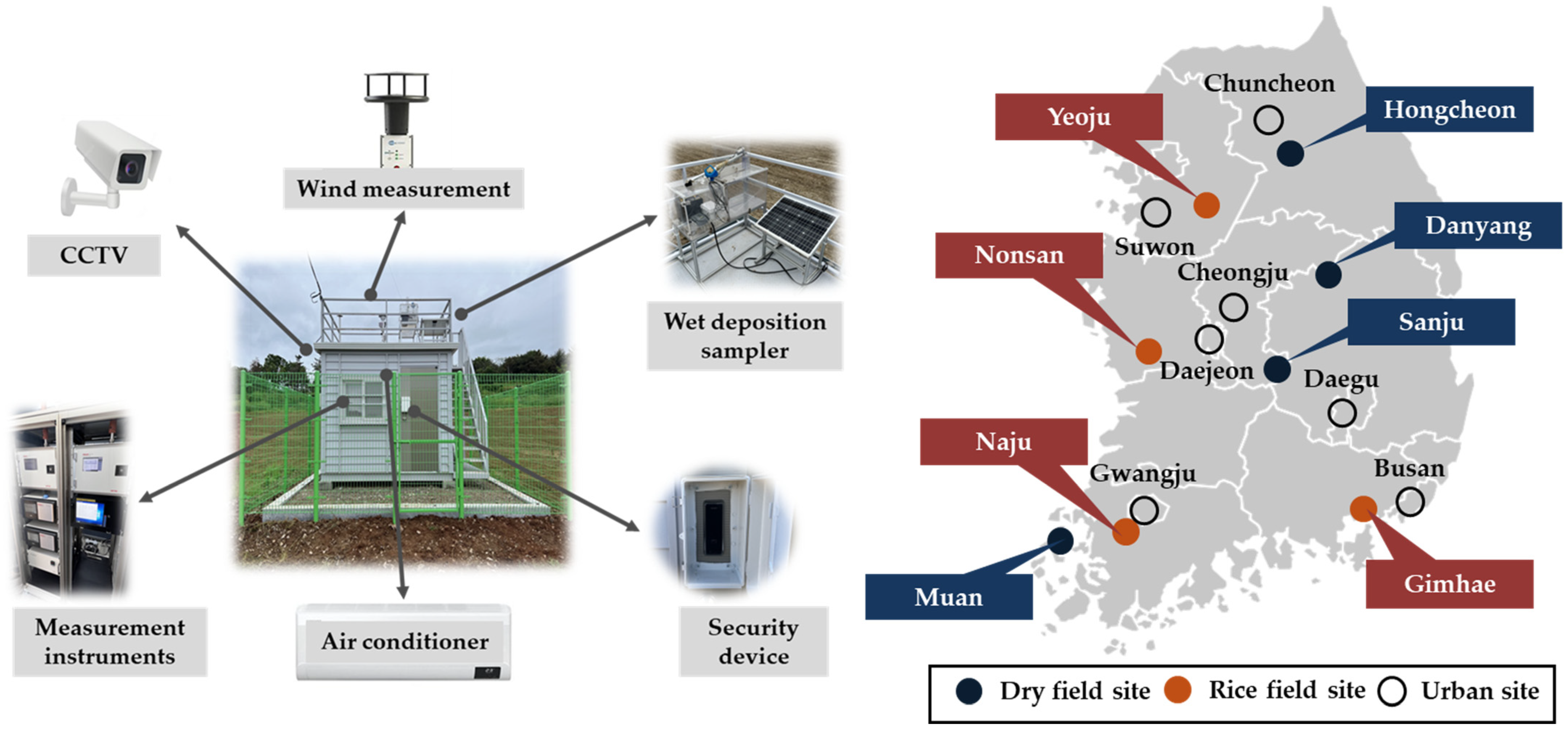
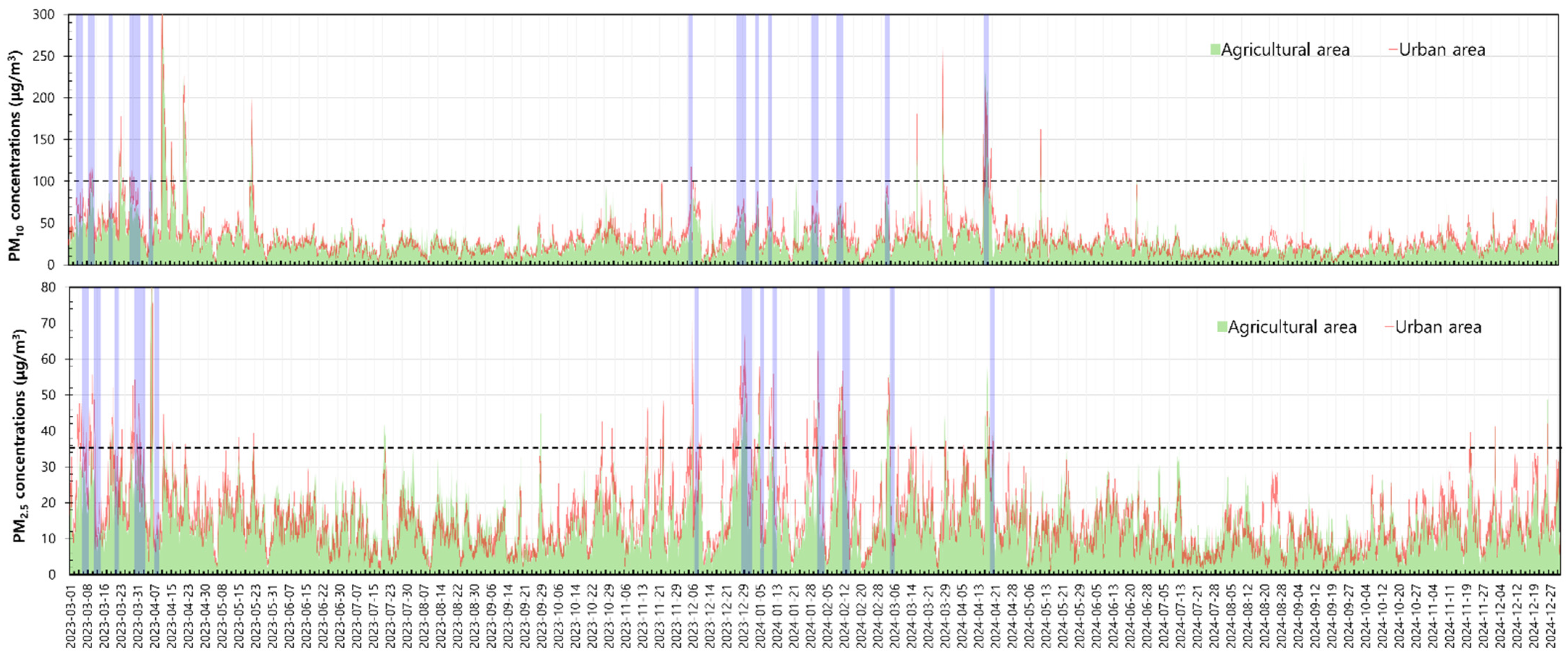
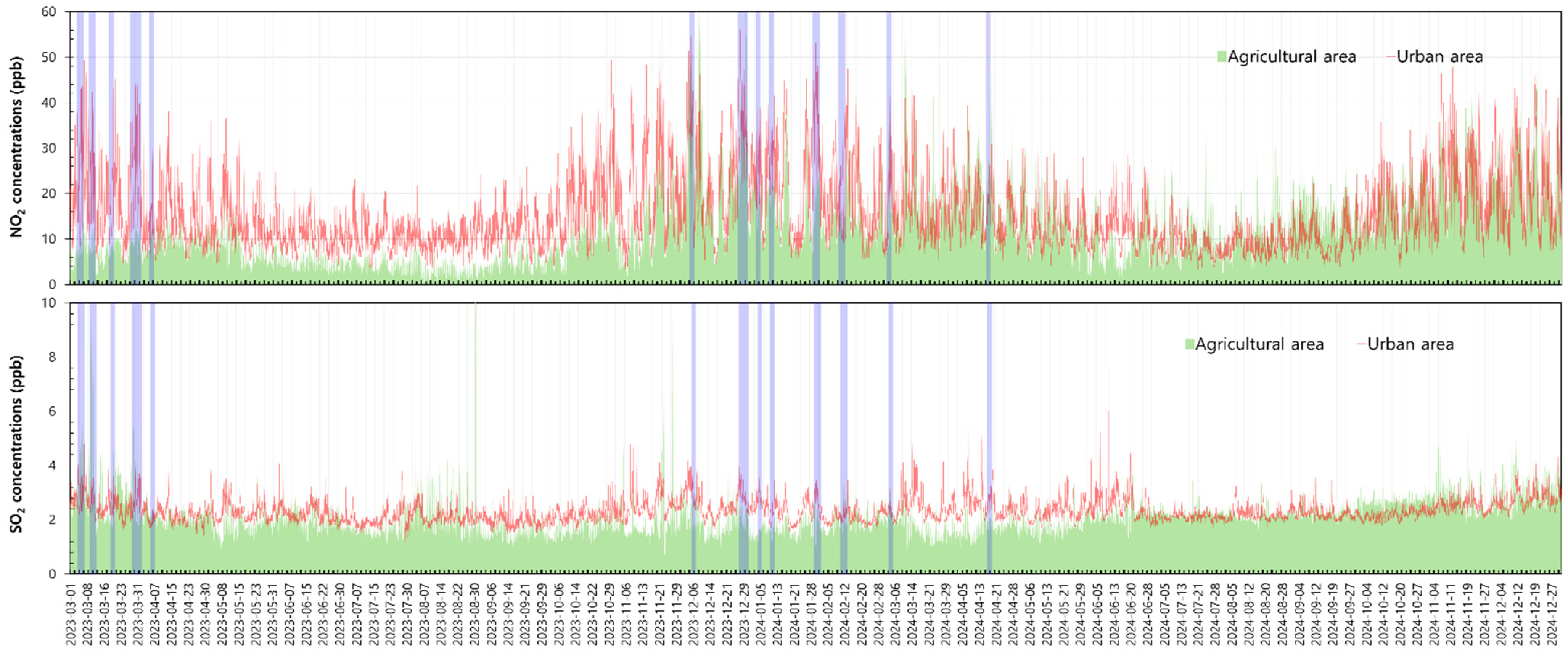


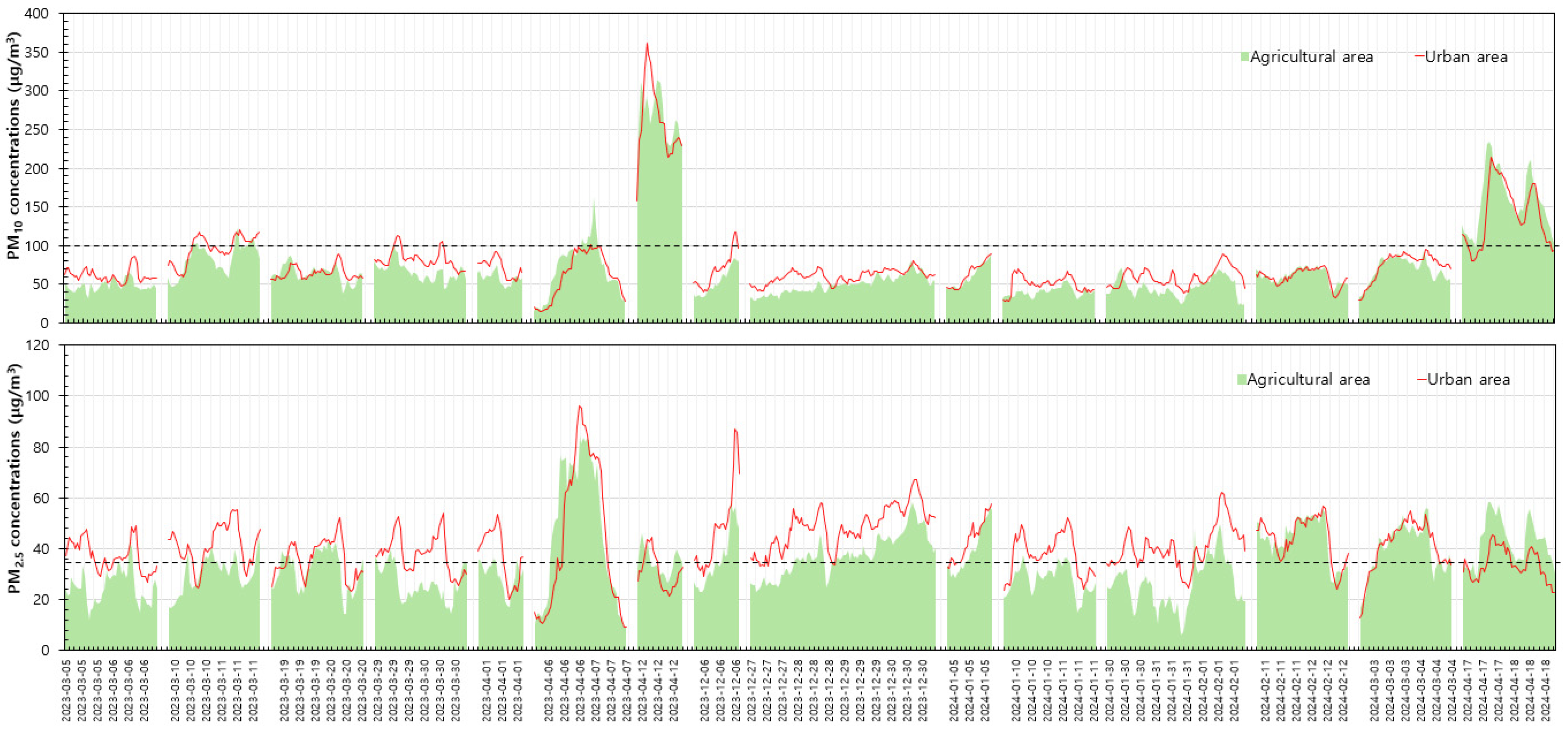
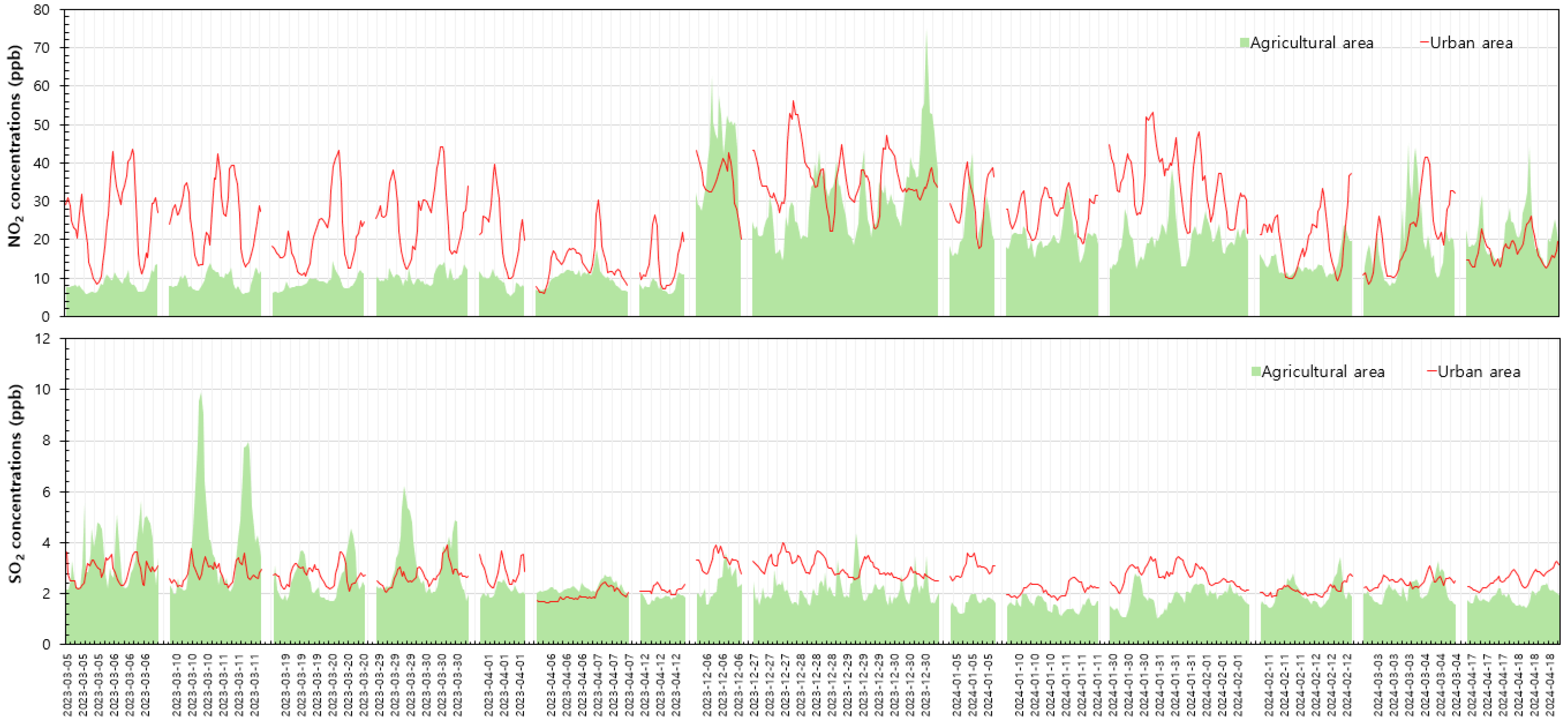
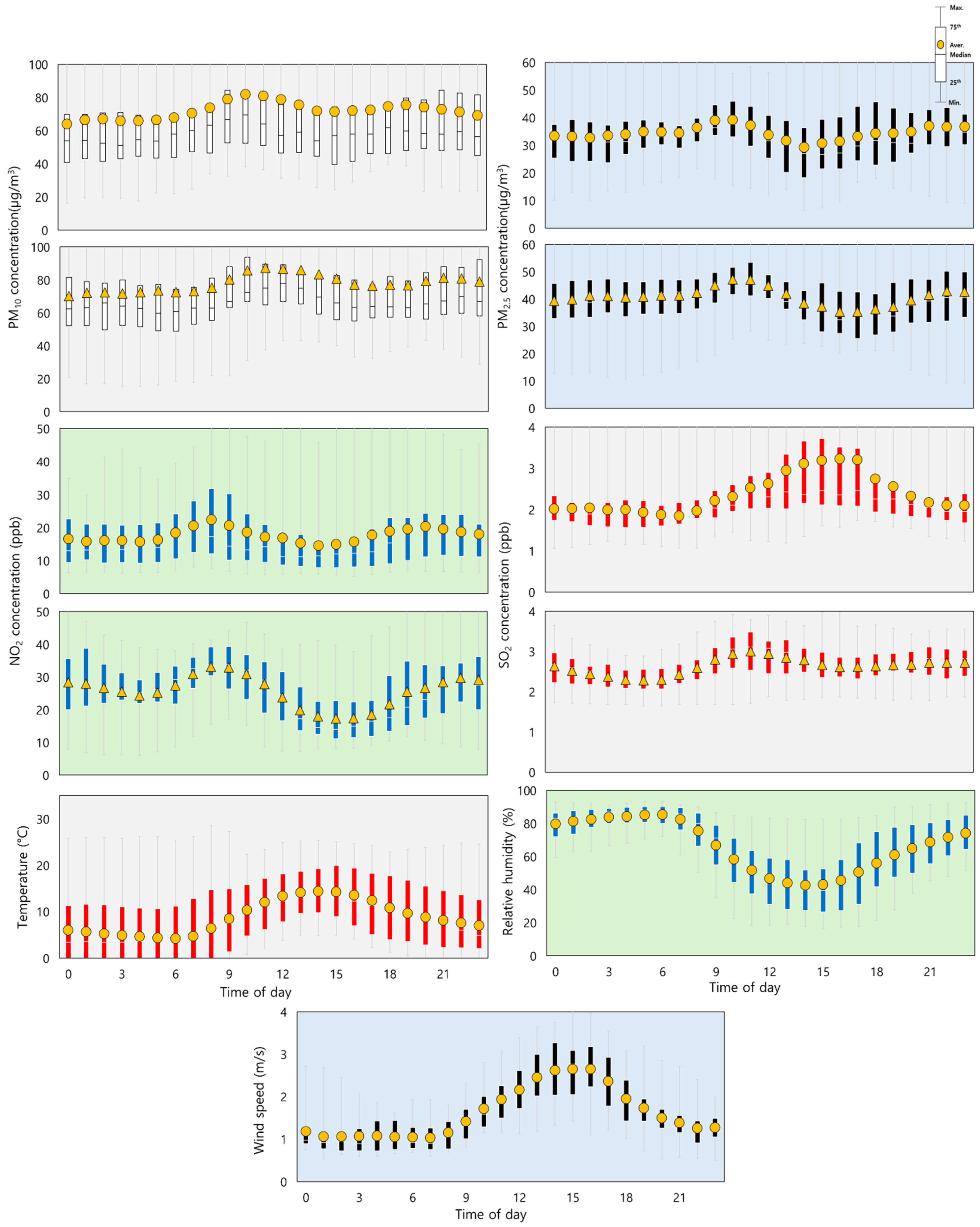
| PM10 (μg/m3) | PM2.5 (μg/m3) | NO2 (ppb) | SO2 (ppb) | |||||
|---|---|---|---|---|---|---|---|---|
| Urban | Agricultural | Urban | Agricultural | Urban | Agricultural | Urban | Agricultural | |
| Period | March 2023 to December 2024 | |||||||
| Average | 31.36 | 31.04 | 15.52 | 15.50 | 15.42 | 12.50 | 2.33 | 2.11 |
| Maximum | 361.67 | 313.46 | 96.00 | 84.67 | 56.14 | 74.88 | 7.63 | 11.56 |
| 75th | 37.43 | 35.97 | 19.71 | 19.72 | 19.32 | 17.03 | 2.53 | 2.39 |
| Median | 25.86 | 26.09 | 13.50 | 14.04 | 12.90 | 10.56 | 2.24 | 2.04 |
| 25th | 17.86 | 18.70 | 8.71 | 9.49 | 9.39 | 6.16 | 2.04 | 1.65 |
| Minimum | 2.00 | 1.72 | 1.00 | 0.68 | 3.27 | 0.34 | 1.18 | 0.56 |
| Period | March 2023 to December 2023 | |||||||
| Average | 34.77 | 34.22 | 16.54 | 16.44 | 15.22 | 8.80 | 2.28 | 2.01 |
| Maximum | 361.67 | 313.46 | 96.00 | 84.67 | 56.14 | 74.88 | 4.80 | 11.56 |
| 75th | 41.00 | 39.26 | 20.67 | 21.05 | 18.46 | 10.36 | 2.49 | 2.24 |
| Median | 27.67 | 28.30 | 14.29 | 15.06 | 12.70 | 6.63 | 2.20 | 1.86 |
| 25th | 18.71 | 19.86 | 9.43 | 10.17 | 9.46 | 4.13 | 1.99 | 1.55 |
| Minimum | 2.29 | 2.86 | 1.00 | 1.02 | 3.27 | 0.34 | 1.18 | 0.56 |
| Period | January 2024 to December 2024 | |||||||
| Average | 28.50 | 28.38 | 14.66 | 14.72 | 15.59 | 15.60 | 2.37 | 2.19 |
| Maximum | 260.57 | 233.77 | 62.33 | 58.32 | 53.14 | 57.65 | 7.63 | 7.68 |
| 75th | 34.71 | 33.31 | 18.86 | 18.36 | 20.09 | 19.93 | 2.56 | 2.50 |
| Median | 24.71 | 24.52 | 12.86 | 13.26 | 13.10 | 14.28 | 2.29 | 2.15 |
| 25th | 17.00 | 17.95 | 8.14 | 9.05 | 9.33 | 10.03 | 2.09 | 1.80 |
| Minimum | 2.00 | 1.72 | 1.00 | 0.68 | 3.29 | 0.96 | 1.59 | 0.77 |
| PM10 (μg/m3) | PM2.5 (μg/m3) | NO2 (ppb) | SO2 (ppb) | |||||
|---|---|---|---|---|---|---|---|---|
| Urban | Agricultural | Urban | Agricultural | Urban | Agricultural | Urban | Agricultural | |
| Average | 77.98 | 71.98 | 40.85 | 34.40 | 25.71 | 17.69 | 2.63 | 2.38 |
| Maximum | 361.67 | 313.46 | 96.00 | 84.67 | 56.14 | 74.88 | 3.98 | 9.91 |
| 75th | 83.74 | 75.69 | 47.71 | 40.81 | 33.48 | 21.97 | 2.99 | 2.47 |
| Median | 66.75 | 57.86 | 39.86 | 33.02 | 25.51 | 14.01 | 2.60 | 2.09 |
| 25th | 55.68 | 44.82 | 32.86 | 25.88 | 17.00 | 9.70 | 2.27 | 1.81 |
| Minimum | 15.14 | 15.91 | 9.14 | 6.37 | 5.96 | 5.11 | 1.64 | 1.06 |
Disclaimer/Publisher’s Note: The statements, opinions and data contained in all publications are solely those of the individual author(s) and contributor(s) and not of MDPI and/or the editor(s). MDPI and/or the editor(s) disclaim responsibility for any injury to people or property resulting from any ideas, methods, instructions or products referred to in the content. |
© 2025 by the authors. Licensee MDPI, Basel, Switzerland. This article is an open access article distributed under the terms and conditions of the Creative Commons Attribution (CC BY) license (https://creativecommons.org/licenses/by/4.0/).
Share and Cite
Baek, J.-D.; Joo, H.-S.; Bae, S.-H.; Oh, B.-W.; Kim, M.-W.; Kim, J.-H. Comparative Analysis of Air Quality in Agricultural and Urban Areas in Korea. Agriculture 2025, 15, 1027. https://doi.org/10.3390/agriculture15101027
Baek J-D, Joo H-S, Bae S-H, Oh B-W, Kim M-W, Kim J-H. Comparative Analysis of Air Quality in Agricultural and Urban Areas in Korea. Agriculture. 2025; 15(10):1027. https://doi.org/10.3390/agriculture15101027
Chicago/Turabian StyleBaek, Jeong-Deok, Hung-Soo Joo, Sung-Hyun Bae, Byung-Wook Oh, Min-Wook Kim, and Jin-Ho Kim. 2025. "Comparative Analysis of Air Quality in Agricultural and Urban Areas in Korea" Agriculture 15, no. 10: 1027. https://doi.org/10.3390/agriculture15101027
APA StyleBaek, J.-D., Joo, H.-S., Bae, S.-H., Oh, B.-W., Kim, M.-W., & Kim, J.-H. (2025). Comparative Analysis of Air Quality in Agricultural and Urban Areas in Korea. Agriculture, 15(10), 1027. https://doi.org/10.3390/agriculture15101027






